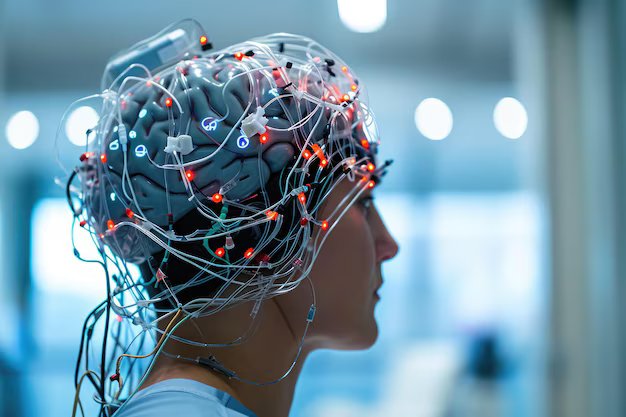
image credit- shutterstock
A Chinese man who lost all four limbs in a high-voltage electrical accident 13 years ago can now play chess and racing games using only his mind. This is not a scene from Chrisopher Nolan’s sci-fi film, but the result of China’s first-in-human clinical trial of an invasive brain–computer interface (BCI)—a milestone in moving the technology from laboratory research to clinical application.
In this landmark case, a BCI device was implanted directly into his brain, allowing him to control digital environments purely through neural signals. The trial, a collaboration between the Center for Excellence in Brain Science and Intelligence Technology (CEBSIT) at the Chinese Academy of Sciences (CAS) and Huashan Hospital, makes China the second country after the United States to advance invasive BCI technology to the clinical trial stage.
Since the device was implanted in March 2025, it has functioned stably with no infection or electrode failure, according to the research team. The scientists expect that, pending regulatory approval, the system could reach the market by 2028. It holds significant potential to improve the quality of life for millions of people suffering from complete spinal cord injuries, double upper-limb amputations, and amyotrophic lateral sclerosis (ALS).
China’s progress extends beyond mobility restoration. Researchers at the Beijing Institute for Brain Research achieved the country’s first clinical application of a wireless implanted Chinese-language BCI system, marking a breakthrough for speech-disability interventions. These developments highlight the speed at which China’s neurotechnology field is moving from experimentation to real-world applications.
BCI is now one of the fastest-growing frontiers of health innovation in the country. A 2023 report from the China Academy of Information and Communications Technology and the Brain–Computer Interface Industrial Alliance identified over 30 potential application areas for BCI, with healthcare accounting for more than 55 per cent. The remaining opportunities lie in consumer technology, manufacturing, and education.
According to Tracxn, there are 275 companies globally working in this space, developing applications to treat epilepsy, Parkinson’s disease, and other neurological disorders, as well as to restore or enhance motor and sensory functions.
In the United States, pioneers such as Elon Musk’s Neuralink—which closed a $650 million Series E round in June 2025 are advancing BCI technology that translates neural signals into digital actions. Other notable players include Synchron, which is developing an endovascular BCI for paralysis rehabilitation, along with Cumulus Neuro, Precision Neuroscience, and Paradromics.
China’s Roadmap to BCI
China’s brain–computer interface (BCI) sector is evolving rapidly, supported by innovation clusters, major infrastructure launches, and a comprehensive national roadmap designed to build global leadership in neurotechnology.
Regional clusters have emerged as the backbone of this growing ecosystem. According to CCID Consulting, Guangdong now hosts the largest concentration of BCI companies of about 80 key enterprises as of 2024 followed by Jiangsu (37), Zhejiang (28), and Beijing (26) bringing the total to around 170 companies nationwide as of 2024. Despite having fewer companies, Beijing leads in innovation output, filing 484 BCI-related patents in 2024, ahead of Guangdong (360) and Tianjin (294).
Recent months have also seen a flurry of high-profile developments. In October 2025, Tianjin launched the world’s first magnetic resonance platform customised for BCI technology, establishing a dedicated neuroimaging system to support next-generation research and development. Earlier, in June 2025, Shanghai inaugurated China’s first dedicated brain–computer industry hub, signaling a coordinated national effort to move BCI from the lab to large-scale application.
At the policy level, the country’s direction is guided by the Implementation Opinions on Promoting the Innovation and Development of the Brain–Computer Interface Industry, jointly issued by seven key ministries and agencies, including the Ministry of Industry and Information Technology, the National Development and Reform Commission, the National Health Commission, and the Chinese Academy of Sciences. In August 2025, this comprehensive blueprint outlines a staged plan to accelerate technological breakthroughs, industrial development, and ethical governance.
Under this roadmap, by 2027, China aims to achieve breakthroughs in key BCI technologies and establish a complete technical, industrial, and standardisation system. The performance of electrodes, chips, and devices is expected to reach internationally advanced levels, with BCI applications expanding rapidly across industrial manufacturing, healthcare, and consumer technologies. The plan envisions the creation of two to three major industrial clusters, pioneering new scenarios and business models.
By 2030, the country’s BCI innovation capability is projected to rank among the best in the world, supported by a safe, reliable, and globally competitive industrial system. The goal is to nurture two to three globally influential companies and a group of specialised, innovation-driven SMEs, forming an ecosystem with international competitiveness and sustainable growth.
The roadmap is detailed through 17 key action areas, focusing on strengthening research, industrial capability, and governance. These include:
What Other APAC Countries Are Doing
Beyond China, the race to advance BCI technology is gaining momentum across Asia–Pacific, with Japan taking the lead.
Launched in 2018, Japan’s Strategic International Brain Science Research Promotion Program (Brain/MINDS Beyond) aims to advance global brain research through international collaboration. Building on national programmes such as Strategic Research Program for Brain Sciences (SRPBS) and Brain/MINDS under the Japan Agency for Medical Research and Development (AMED), the initiative focuses on:
The programme seeks to uncover the brain’s functional principles for early detection and intervention in neurological and psychiatric disorders, while also contributing to AI development inspired by brain computation. It aligns with global efforts like the US BRAIN Initiative and the EU Human Brain Project, reflecting Japan’s commitment to international collaboration and scientific leadership in neuroscience.
Japan also hosts some of Asia’s most advanced BCI research centres. Japan’s BCI-Lab Group conducts multisensory BCI research—auditory, tactile, and increasingly visual and olfactory—developing algorithms for biomedical signal analysis to enable future all-sensory BCI systems. At Osaka University, Professor Takufumi Yanagisawa has pioneered ECoG-based brain–machine interfaces, helping patients with ALS or stroke regain motor and communication abilities and exploring applications for phantom limb pain. Meanwhile, at the University of Tsukuba, Professor Natsue Yoshimura is using AI to decode brain waves, reconstructing movement and speech patterns to bridge neuroscience with computational intelligence.
South Korea is also ramping up support for BCI research. In January 2025, Ybrain, a digital therapeutics firm, was chosen as an R&D partner under the Global Industry Technology Cooperation Center project, led by the Ministry of Trade, Industry and Energy and supervised by Korea Institute for Advancement of Technology (KIAT). Working with Korea Electronics Technology Institute (KETI), Korea Institute of Science and Technology (KIST), Pusan National University, ETH Zurich, and The French National Centre for Scientific Research (CNRS), Ybrain is developing wearable robotic systems using minimally invasive BCI technology for paralysis rehabilitation—a national first. The government has pledged ₩6 billion (US$4.6 million) through 2027. Meanwhile, Korea Advanced Institute of Science & Technology (KAIST)’s Brain Interfaces and Neural Prosthetics Laboratory (BINP Lab) is advancing neural interfaces and prosthetic technologies for neurological and cognitive disorders.
In Singapore, researchers at Duke-NUS Medical School’s Neuroscience & Behavioural Disorders Signature Research Programme are exploring BCI-driven cognitive interventions for neuropsychiatric disorders.
Ethical Concerns
As BCI moves toward commercialisation, experts warn that innovation is outpacing ethical and legal safeguards. Studies point to growing concerns around data privacy, cognitive autonomy, and human rights, alongside unresolved medical risks linked to invasive implants and their long-term effects on cognition and mental health.
To address these issues, China in 2024 issued national ethical guidelines for BCI research and applications, one of the first state-level frameworks globally, emphasising informed consent, patient safety, and secure data management.
Internationally, frameworks such as the Organization for Economic Co-operation and Development (OECD)’s Recommendation on Responsible Innovation in Neurotechnology (2019, updated 2023) and UNESCO’s 2023 Declaration on the Ethics of Neuroscience and Neurotechnology outline principles for transparency, accountability, and human dignity. The OECD’s 2023 standard remains the most comprehensive global reference, guiding policymakers and developers to align neurotechnology progress with responsible innovation.
By prioritising BCI within its broader innovation agenda, China is signalling that brain–machine communication is no longer confined to science fiction, it’s rapidly becoming a scientific and industrial reality, reshaping the future of healthcare.
Ayesha Siddiqui



